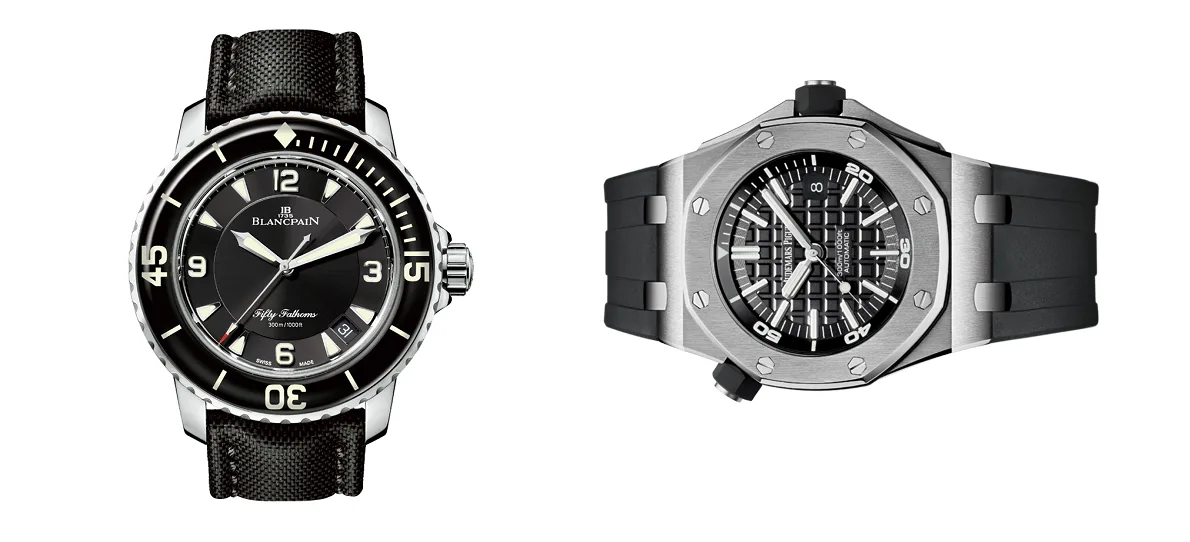By Harlan Chapman-Green
Welcome to the last article in our monthly recurring series Clash of the Divers where we put two heavyweights in the ring and see who’s the victor when the bell sounds the end. We’ve had a lot of fun over the past six months and it has brought us some unique insights into people’s personal choices as well. We feel that it was this series that connected us with our audience the most, perhaps it was simply because of the type of watches we were covering. The last series, the Tourbillon Trials, featured extremely expensive wristwatches that are simply out of the reach of a lot of people.
We started the series with a bang when we put an Omega Seamster against a Rolex Submariner in a classic battle that’s the equivalent of Mac vs PC or Mercedes Benz vs BMW. We were surprised when our incredibly complicated mathematics algorithms (like, seriously complicated) showed us that the Omega was the superior watch and therefore the winner for November.
Now we’re back with another controversial fight in the form of two heavy hitting watches going together, the fantastic Audemars Piguet Royal Oak Offshore Diver and the classic yet brilliant Blancpain Fifty Fathoms. Before we begin I should mention that both watches we’ll be comparing are the three hand date variants of the watches. Audemars also offers four recently introduced Diver Chronograph watches that come in different colours while Blancpain offers a massive array of complications from the flyback chronograph all the way up to an 8-day tourbillon, that’s before we even mention the Fifty Fathoms Bathyscaphe watches too.
We’ll go alphabetically, which means we get to look at the Audemars Piguet Royal Oak first. Before we look in depth at the Diver, let me tell the story of Audemars Piguet and how the Royal Oak saved their bacon.

It was the early 1970s when a small watch company based in Le Brassus realised it had a problem. The quartz revolution had just kicked in and sent shockwaves around the industry, the battery powered watches were cheaper, more accurate and more robust than their mechanical counterparts. It didn’t take long for companies to realised they’d need to move fast or go broke, unfortunately, the decision took too long for a lot of names and they had no choice but to pack up and go home.
Audemars Piguet had the same trouble, so in a last bid to save themselves they drafted in Gerald Genta to design them a new watch. The result of his labours was the iconic Royal Oak, the first watch to make stainless steel a luxurious metal for a wrist watch. It also has exposed screws on it, much like Cartier’s Santos which has exposed pins on the bezel. This helped to change the way we see watches, beforehand screws and such were to be hidden away, but there’s now an elegance to them.
The Offshore watches came in 20 years later in 1992 as a sort of birthday present Audemars gave to itself, so don’t worry bachelors, you’re not alone. The Offshore watches are the chunky, sportier Royal Oak watches nowadays while the Royal Oak itself has become more sports/dress, but there’s nothing wrong with that now is there?

This particular is the diving variant and as such has some features catering to the task. First off is the case, it’s pretty chunky at 42mm in diameter and 14.1mm thick. Sure it’s not Omega Seamster Ploprof dimensions but compared to the other watches in the range it’s definitely got some heft to it. All that steel isn’t just for nothing, though, the watch is 300m water resistant meaning it’s all ready to go on sporting escapades.
To make this truly a diving watch there needs to be a functional bezel, despite having computers and such to measure pretty much everything I’d still prefer to set my watch ready for a dive before I go in anyway, not as a last resort (although it may end up that way) but more as a personal thing. If there’s something there, you might as well use it, it’s the same for me with all the features on the washing machine. As I was saying earlier, to make this watch a functioning scuba diving watch AP have fitted it with an inner mounted rotating bezel that’s controlled by a crown at 10 O’clock, exactly the same place Omega puts their Helium Escape Valve, I must confess that the first time I saw this a couple of years ago I thought it also had an HE valve.
As I spoke about in the Longines vs Oris edition of Clash of the Divers, the advantage of an inner rotating bezel is that it’s much harder to accidentally knock out of position when diving, nowadays this is countered by the fact that diving bezels are uni-directional anyway. On this AP though it has another feature and that’s to keep that iconic bezel in place, it wouldn’t be a Royal Oak otherwise would it?

Showing Audemars Piguet’s attention to detail off are small touches such as the crowns which are clad in the same rubber that’s used on the strap and the ‘Mega Tapisserie’ dial (which comes in either black or white). If you turn the piece over you’ll be greeted by a marvel of the movement world, the AP self-winding calibre 3120 with a hand made and finished mono-bloc 22K gold winding rotor which uses ceramic ball bearings as lubrication to ensure it never needs to be oiled up. The movement has a 60-hour power reserve and consists of 280 individual parts, it operates at 3Hz.

The Royal Oak Offshore Diver watch is a brilliantly designed piece of functional artwork for the modern man. It transcends the expectations by being elegant but as rugged as any other sports watch, some owners even experience durability on par with Rolex watches from these pieces, so the Offshore is a no brainer. But is it?

It’s not even really had a mention in this series yet despite its iconic status, although Audemars Piguet’s Royal Oak Offshore Diver watch is a great piece of engineering, its status in the league of sports watches is rather overshadowed by what is now seen as the archetypal diving watch; the Blancpain Fifty Fathoms.
Just like the Offshore Diver, the Fifty Fathoms is a scuba diving sports watch through and through. They’re both made of steel, they both sport 300m of water resistance and they both have a date window on the dial. However, I can’t think of another sports watch right now with as much pedigree as the Fifty Fathoms except the Omega Speedmaster. Let’s go right back to the beginning to learn more about this watch, its origins and how it beat Rolex.

In the early 1950s two companies sat down to work on a new type of wristwatch, this watch should be supremely water resistant to meet the demands of the customers who are becoming more adventurous in their activities, particularly those activities based around the substance that makes up seven-tenths of our planet’s surface, H2O, or as it’s commonly known, water. We’d been exploring the skies for decades by this time from our flying machines and although we had pretty much-perfected submarines as a running concept, we still couldn’t really explore the depths of the ocean personally.

When the technology came along to allow us to scuba dive, we needed a way to keep a track of time, and what better to keep the time than a high-quality wristwatch? The Swiss knew of the trend and both Blancpain and Rolex got straight onto making the perfect watch for the job. At this point I should mention history gets a little fuzzy with some claiming Blancpain stole Rolex designs and vice versa, I prefer to think of it as one of those times where both were working on pretty much the same thing without either party knowing it, but ultimately Blancpain beat Rolex by a year in releasing their watch, the Fifty Fathoms.

Over the years, it has changed a bit but it is well and truly for the better with this watch. The first Fifty Fathoms was a revolution in watches, so it can only go up from there. Where the Audemars Piguet is a sort of in your face industrial piece of art, the 45mm Fifty Fathoms covers it up with soft curves and bulging sides, in fact, there’s hardly a straight line on it.

The bezel of the watch is more traditional in terms of operation, it’s an outer rotating design which means that you can operate it with your gloves with ease, although I don’t see why you’d need to when on a dive. For other uses, it’s less fiddly which is nice, though. The markers on the bezel are lured as well, it’s not something we see very often but there is a good reason for it. Unlike pretty much every diving watch save the Ploprof cal.8500 the bezel is not made of super hard ceramic or stainless steel. That bulging bezel is made of sapphire crystal and is domed on the top, a very very hard thing to do. The sapphire crystal over the dial is softly curved around the edges as well making for a spectacular show of design in some lights.

It wouldn’t be right to do this and not mention the dial. I can’t think of any diving watch which has this much attention to detail on it. The sunburst dial is hand finished and something I’d expect to see on a dress watch rather than a sports watch, the downside is that the black dialled version doesn’t have this special treatment, but some people will prefer this. The green lume covers all of the markers, the hands (including the seconds hand) and of course, the bezel as well.
The movement in this watch, unlike the Audemars Piguet, is not on display and is instead covered by a clean polished steel caseback with some writing and numbers on it. On models such as the Chronograph Quantieme Complet that caseback is see through with a nautilus rotor (not the Patek Nautilus, but it really does look like the sea nautilus. The calibre 1315 movement inside this watch is automatic winding and has a seriously long power reserve of 120 hours.
Now we’ve looked at both we’re down to that difficult decision for the last time. Royal Oak or Fifty Fathoms? Mega Tapisserie or Sunburst Guilloche? A rubber sports strap or a sail canvas strap (you can get a steel bracelet if you like, I’ve heard nothing negative about either one).

The winner of this edition of Clash of the Divers is the Blancpain Fifty Fathoms, the AP ROO Diver is a neat watch, but it doesn’t have what it takes to shift the Fifty Fathoms, heck, not even the Submariner can do that and the range is only 1 year younger and wildly more popular. For more info, please visit blancpain.com & audemarspiguet.com
Thank you for following this series, it’s been a wild ride for sure!

HARLAN CHAPMAN-GREEN – MANAGING EDITOR
A keen bass guitar player, Harlan enjoys all the perks modern watchmaking technologies the industry has to offer. Although you might catch him sampling Omegas or the “odd” Rolex, Harlan loves all things Haute Horology, with his three favourite brands being Breguet, A.Lange & Söhne and Vacheron Constantin. He hopes to study timekeeping more in depth someday and will never be able to thank his father enough for introducing him to the industry. You can follow him on Instagram Read his articles here



